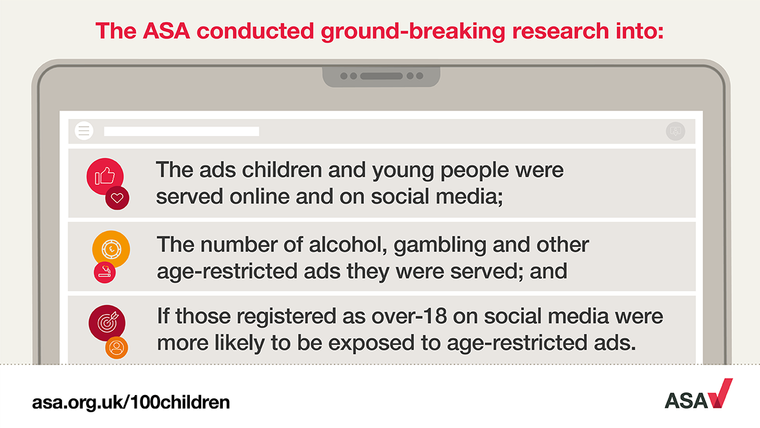
Exposure to all online ads: Over the course of one week, there were 11,424 occasions when an online ad was served to the mobile devices of the 97 children, aged 11-17, who participated in our monitoring.
Exposure to age-restricted ads: 435 occasions (3.8% of the total) related to ads for alcohol, gambling and other age-restricted ads, which are subject to the ASA’s twin pillars of regulation: media placement rules, which restrict the media environments in which these ads can be placed and - in media where these ads are permissible - rules that restrict the ads from inappropriately appealing to children.
Registering false dates of birth: Findings from the study would suggest that around 93% of all 11–17-year-olds in the UK have a personal account with one or more of the major social media platforms. With over five million people in the UK aged between 11-17, each with an average of around three social media accounts, this age group is estimated to hold over 15 million social media accounts. Our findings would suggest that on at least 11% of these accounts, children are registered with a date of birth that suggests they’re 18 or older, implying that over 1.6 million social media accounts held by children in the UK are falsely registered with an adult age. Our report also found that 86% of 11–12-year-olds have their own account on at least one social media platform. Since they fall below the minimum age of registration (13) on social media, their submitted date of birth almost certainly signifies they’re older than they actually are.
“Under 18” age-registered social media accounts and children’s online sites: there were 73 occasions (0.6% of the total number of ads) when, in likely breach of the targeting rules, age-restricted ads were served by 30 advertisers to 10 of the children on our Panel through:
- the social media accounts that children, in our study, self-reported as being registered with an age of 17 or younger, or
- a separate online site where children make up more than 25% of the audience.
The ASA is – as a priority – following up with these advertisers in the first instance (and the platforms, where relevant) to corroborate our findings and, as necessary, secure remedial action and assurances of future compliance.
“Over 18” age-registered social media accounts and online sites predominantly composed of adults: There were 261 occasions (2.3% of the total number of ads) when age restricted ads were served by 65 advertisers to 25 children through:
- the social media accounts that children, in our study, self-reported as being registered with an age of 18 or older, or
- multiple other online environments where adults make up more than 75% of the audience.
These ads are not, on the face of it, in breach of the targeting rules. The ASA will nevertheless follow up with these advertisers to ensure they are aware of and applying ground-breaking new guidance from the Committee of Advertising Practice to ensure they are doing everything they can to minimise children’s exposure to their age-restricted ads.
Taking the extra step to limit children’s exposure to age-restricted ads online: Limiting children’s exposure to age-restricted ads in nominally adult social media accounts and other online sites predominantly composed of adults is a developing field of the ASA’s regulation and one in which it and its sister body, CAP, will consider pioneering work in 2023, potentially leading to investigations and published rulings.
“Under 18” v “Over 18” exposure: It is notable – and a likely consequence of children registering with false dates of birth on social media - that children registered as 18 or older were exposed to 47% of all the age-restricted ads captured in our study, almost two-thirds more than children registered as 17 or younger (29%).
Online v TV: Our study found that, on average, each child was served 3.7 online ads for alcohol and gambling over the monitored week. Of these, 0.7 ads related to ads likely to breach the targeting rules, and 3.0 ads were not, on the face of it, in breach of the targeting rules. Whilst not directly comparable to TV (owing to significant differences in sample size, the profile of the sample, the timeframe of the study and many other methodological differences) the ASA’s latest TV advertising exposure report found that children aged 4-15 saw, on average, 3.0 TV ads for the same products per week. To the best of our knowledge, few if any of the TV ads were in breach of the relevant scheduling rules.
Intermediary and Platform Principles Pilot: Through this global-first pilot, ten of the world’s largest online advertising supply businesses volunteer to take reasonable and appropriate measures to make advertisers and agencies aware of the tools or controls that can be used on their services to help comply with advertising rules on the targeting of age-restricted ads online. This is one of six Principles that the participating businesses have volunteered to implement to help raise awareness of the ASA and the rules that apply to online paid ads, and to support the ASA in exceptional cases where an advertiser refuses to amend or withdraw a non-compliant ad online.
Transparency through public reporting: The ASA will report publicly in early 2023 on any follow-up enforcement action it takes as a result of the findings from the 100 Children Report. The ASA’s interim report on the Intermediary and Platform Principles Pilot, independently commenting on how participating companies have, to date, implemented the Principles, will be published on the ASA website before the end of 2022.
Read the ASA’s full 100 Children Report now.
More on
-
Keep up to date
Sign up to our rulings, newsletters and emargoed access for Press. Subscribe now.


